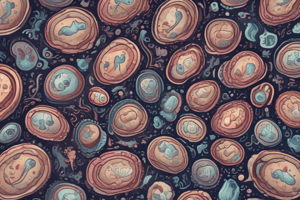Podcast
Questions and Answers
What is the primary target of sporozoites after ingestion of oocysts by humans?
What is the primary target of sporozoites after ingestion of oocysts by humans?
- Muscle cells
- Brain cells
- Intestinal epithelial cells (correct)
- Blood cells
In which organs or tissues do bradyzoite cysts commonly encyst?
In which organs or tissues do bradyzoite cysts commonly encyst?
- Skeletal muscle, myocardium, brain, and the eyes (correct)
- Kidneys and pancreas
- Stomach and small intestine
- Lungs and liver
What percentage of healthy individuals in Latin America are seropositive for T. gondii?
What percentage of healthy individuals in Latin America are seropositive for T. gondii?
- 10-20%
- 80-90%
- 50-80% (correct)
- 20-40%
How does the immune system respond to T. gondii in immunocompetent hosts?
How does the immune system respond to T. gondii in immunocompetent hosts?
What is the typical clinical presentation of acute toxoplasmosis in healthy individuals?
What is the typical clinical presentation of acute toxoplasmosis in healthy individuals?
What is the final stage of T. gondii in immunocompetent hosts?
What is the final stage of T. gondii in immunocompetent hosts?
What is the stage of the Toxoplasma gondii parasite that remains in the body after symptoms disappear?
What is the stage of the Toxoplasma gondii parasite that remains in the body after symptoms disappear?
Which of the following populations is at high risk of developing severe toxoplasmosis?
Which of the following populations is at high risk of developing severe toxoplasmosis?
What is a common complication of Toxoplasma gondii infection in the central nervous system (CNS)?
What is a common complication of Toxoplasma gondii infection in the central nervous system (CNS)?
How can Toxoplasma gondii infection be transmitted to a fetus?
How can Toxoplasma gondii infection be transmitted to a fetus?
What is the primary method of laboratory diagnosis for toxoplasmosis?
What is the primary method of laboratory diagnosis for toxoplasmosis?
What is the risk of transmitting Toxoplasma gondii to the fetus for pregnant women with HIV infection?
What is the risk of transmitting Toxoplasma gondii to the fetus for pregnant women with HIV infection?
What is the primary route of transmission for humans to become infected with Toxoplasma gondii?
What is the primary route of transmission for humans to become infected with Toxoplasma gondii?
What is the function of merozoites in the life cycle of Toxoplasma gondii?
What is the function of merozoites in the life cycle of Toxoplasma gondii?
Which of the following is NOT a way humans can become infected with Toxoplasma gondii?
Which of the following is NOT a way humans can become infected with Toxoplasma gondii?
What is the role of dendritic cells and monocytes in the dissemination of Toxoplasma gondii?
What is the role of dendritic cells and monocytes in the dissemination of Toxoplasma gondii?
What is the characteristic of Toxoplasma gondii that allows it to infect a wide range of hosts?
What is the characteristic of Toxoplasma gondii that allows it to infect a wide range of hosts?
What is the time period for oocysts to sporulate in the environment and become infective?
What is the time period for oocysts to sporulate in the environment and become infective?
Flashcards are hidden until you start studying
Study Notes
Life Cycle of Toxoplasma Gondii
- Merozoites are responsible for expanding the parasite inside the cat intestine prior to sexual reproduction.
- Sporozoites are the stage of the parasite residing within oocysts.
- Gametocytes (male and female) are formed during the schizogonic phase in the cat's intestine.
Hosts and Transmission
- The only known definitive host for Toxoplasma gondii is the domestic cat and its relatives in the family Felidae.
- Large numbers of unsporulated oocysts are shed in the cat's feces, which take 1-5 days to sporulate in the environment and become infective.
- Intermediate hosts (birds and mammals) become infected after ingesting soil, water, or plant material contaminated with mature oocysts containing sporozoites.
- Humans can become infected by:
- Eating undercooked meat of animals harboring bradyzoites in tissue cysts.
- Blood transfusion or organ transplantation.
- Transplacentally from mother to fetus.
- Consuming food or water contaminated with oocysts containing mature sporozoites.
Infection and Disease
- Toxoplasma gondii is an intracellular parasite that can actively enter any nucleated cell in the host body.
- It disseminates through the host body with infected mobile cells, such as dendritic cells and monocytes, using a "Trojan horse" strategy.
- Infection can lead to diseases, including:
- Encephalitis with large foci of necrosis in gray matter.
- Other neurologic diseases.
- Pneumonia.
- Myocarditis.
- Eye diseases.
Epidemiology
- Serologic prevalence data indicates that toxoplasmosis is one of the most common human infections worldwide.
- Regional seroprevalence rates:
- Latin America: 50-80%.
- Eastern and Central Europe: 20-60%.
- Middle East: 30-50%.
- Southeast Asia: 20-60%.
- Africa: 20-55%.
Clinical Manifestations
- Healthy people infected with T. gondii often do not show symptoms, as their immune system keeps the parasite from causing illness.
- Acute illness is usually mild, with "flu-like" symptoms, and resolves on its own.
- Infants, pregnant women, and immunocompromised people are more vulnerable to severe toxoplasmosis.
- Severe toxoplasmosis can cause CNS complications, pneumonia, myocarditis, and eye diseases.
Laboratory Diagnosis
- Diagnosis of toxoplasmosis in humans is made by:
- Clinical (physical) examination.
- Serological methods (specific antibody detection from serum).
- Histological methods.
- Molecular methods.
Studying That Suits You
Use AI to generate personalized quizzes and flashcards to suit your learning preferences.




